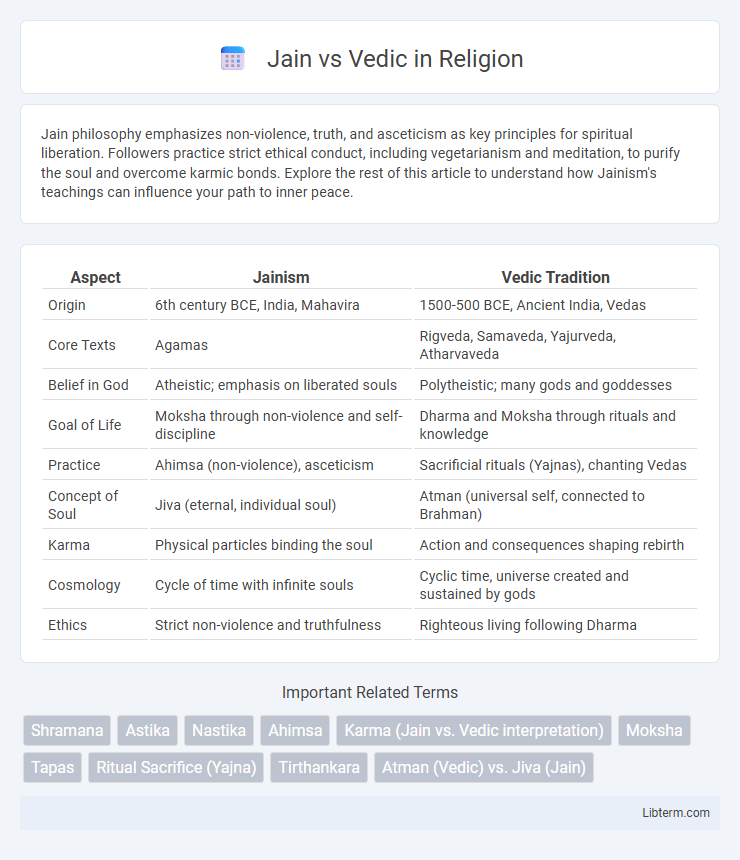Jain philosophy emphasizes non-violence, truth, and asceticism as key principles for spiritual liberation. Followers practice strict ethical conduct, including vegetarianism and meditation, to purify the soul and overcome karmic bonds. Explore the rest of this article to understand how Jainism's teachings can influence your path to inner peace.
Table of Comparison
| Aspect | Jainism | Vedic Tradition |
|---|---|---|
| Origin | 6th century BCE, India, Mahavira | 1500-500 BCE, Ancient India, Vedas |
| Core Texts | Agamas | Rigveda, Samaveda, Yajurveda, Atharvaveda |
| Belief in God | Atheistic; emphasis on liberated souls | Polytheistic; many gods and goddesses |
| Goal of Life | Moksha through non-violence and self-discipline | Dharma and Moksha through rituals and knowledge |
| Practice | Ahimsa (non-violence), asceticism | Sacrificial rituals (Yajnas), chanting Vedas |
| Concept of Soul | Jiva (eternal, individual soul) | Atman (universal self, connected to Brahman) |
| Karma | Physical particles binding the soul | Action and consequences shaping rebirth |
| Cosmology | Cycle of time with infinite souls | Cyclic time, universe created and sustained by gods |
| Ethics | Strict non-violence and truthfulness | Righteous living following Dharma |
Introduction to Jain and Vedic Traditions
Jain traditions emphasize non-violence (ahimsa), asceticism, and liberation through self-discipline, with Mahavira as a central figure around the 6th century BCE. Vedic traditions originate from the ancient Vedas, focusing on rituals, sacrifices, and hymns composed between 1500 and 500 BCE, foundational to Hindu philosophy. Both traditions shape Indian spirituality but diverge in metaphysics, ritual practices, and paths to liberation.
Historical Origins and Development
Jainism originated around the 6th century BCE with the teachings of Mahavira, emphasizing non-violence (ahimsa) and asceticism as key principles. Vedic tradition, rooted in the ancient Indo-Aryan culture dating back to approximately 1500 BCE, centers on ritualistic practices and the authority of the Vedas, ancient sacred texts. The historical development of Jainism shows a shift from Vedic priestly dominance towards a more individualistic and ethical spiritual path.
Core Philosophical Differences
Jain philosophy centers on the principles of non-violence (ahimsa), multiplicity of viewpoints (anekantavada), and the liberation of the soul through strict ethical conduct and self-discipline. Vedic philosophy emphasizes rituals, dharma (duty), and the pursuit of moksha through knowledge (jnana), devotion (bhakti), and meditation, often framed within the framework of the caste system and a pantheon of deities. While Jainism rejects the authority of the Vedas and ritualistic practices, it advocates for non-attachment and self-realization as the path to liberation.
Concept of God and Divinity
Jainism views God as a liberated soul (Siddha) achieved through self-realization and ethical living, rejecting the idea of a creator deity, whereas Vedic tradition embraces a pantheon of gods representing various cosmic principles, rooted in the belief of a supreme, all-pervading Brahman. Divinity in Jainism centers on the soul's potential for Kevala Jnana (omniscience) and Moksha (liberation) through strict adherence to non-violence and asceticism. The Vedic concept emphasizes rituals, dharma, and devotion to deities like Vishnu, Shiva, and Devi, with ultimate unity found in realizing Brahman as the source of all existence.
Rituals and Religious Practices
Jain rituals emphasize non-violence (ahimsa), ascetic practices, and meditation, with ceremonies such as Paryushana focusing on fasting and penance. Vedic rituals center around fire sacrifices (yajnas), chanting of mantras from the Vedas, and offerings to various deities to maintain cosmic order (rita). Jainism rejects animal sacrifice and ritualism found in Vedic traditions, highlighting personal purification and ethical conduct over external rites.
Views on Karma and Liberation
Jainism views karma as a physical substance that binds the soul, emphasizing strict ethical conduct and ascetic practices to eliminate karmic particles and achieve liberation (moksha). In contrast, the Vedic tradition sees karma primarily as action and its consequences, where liberation is attained through rituals, knowledge (jnana), and devotion (bhakti) to transcend the cycle of rebirth (samsara). Jainism's path is more individualistic and empirically based on self-purification, while Vedic philosophies integrate metaphysical beliefs with cosmic order (rita) and divine intervention.
Dietary Principles and Non-Violence
Jain dietary principles emphasize strict ahimsa, requiring complete vegetarianism, avoidance of root vegetables, and fasting to minimize harm to all living beings, reflecting their radical non-violence ethics. Vedic dietary practices, rooted in Hinduism, advocate satvic foods like fruits, grains, and dairy, promoting purity and spiritual growth while permitting some flexibility in diet but generally opposing meat consumption during religious observances. Both traditions uphold non-violence (ahimsa) as a core value, but Jainism enforces more rigorous dietary restrictions to prevent harm to microscopic life forms and prioritize absolute harmlessness.
Social Organization and Caste Perspectives
Jainism emphasizes individual spiritual progress and rejects the rigid caste system, promoting equality among all followers irrespective of social divisions, while Vedic traditions historically integrate caste hierarchy as a fundamental social organization based on varna and ashrama concepts. Vedic society is structured around Brahmins (priests), Kshatriyas (warriors), Vaishyas (traders), and Shudras (laborers), each with prescribed duties and social roles, whereas Jain communities prioritize ethical conduct and non-violence over caste identity. Despite regional variations, Jainism's social framework fosters inclusivity and challenges caste-based discrimination prevalent in Vedic society.
Influence on Indian Culture and Society
Jainism's emphasis on non-violence (ahimsa) deeply influenced Indian ethical practices, promoting vegetarianism and compassion towards all living beings. Vedic traditions contributed significantly through rituals, hymns, and the development of the caste system, shaping social hierarchy and religious ceremonies. Both philosophies enriched Indian art, literature, and moral values, establishing foundational cultural principles that persist in modern Indian society.
Contemporary Relevance and Global Impact
Jainism's emphasis on non-violence (ahimsa) and environmental sustainability resonates strongly in contemporary global movements advocating ethical living and ecological balance. Vedic traditions, foundational to Hindu philosophy, continue to influence modern spirituality, yoga, and meditation practices worldwide, fostering cross-cultural dialogue and wellness industries. Both traditions contribute uniquely to global discussions on morality, consciousness, and sustainable lifestyles, reflecting their enduring contemporary relevance.
Jain Infographic

 libterm.com
libterm.com